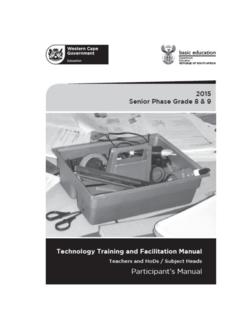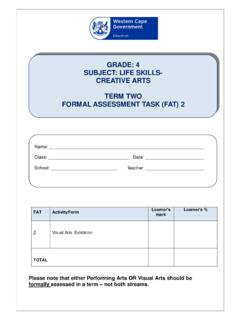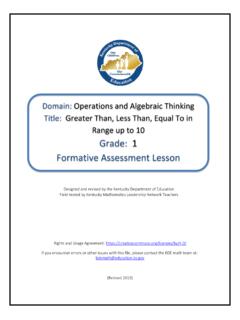Transcription of GRADE: 6 SUBJECT: LIFE SKILLS- CREATIVE ARTS TERM TWO ...
1 FAT Activity/Form Learner s mark Learner s % 2 Visual Arts: Exhibition TOTAL Please note that either Performing Arts OR Visual Arts should be formally assessed in a term not both streams. grade : 6 SUBJECT: LIFE SKILLS- CREATIVE ARTS TERM TWO FORMAL assessment TASK (FAT) 2 Name: _____ Class: _____ Date: _____ School: _____ Teacher: _____ Gr 6 FAT LS CREATIVE Arts: Visual Arts: Term 2 Page | 1 LIFE SKILLS: CREATIVE ARTS FORMAL assessment TASK: VISUAL ARTS grade 6 TERM 2 NOTE TO THE TEACHER: The Formal assessment Task has been developed as a step by step guideline to learners. The activities are to be done in class, during the second term. It is important that teachers mediate the various steps of the task with learners to ensure active, CREATIVE and critical participation by all learners.
2 ACTIVITY 1: CREATE IN 2D, CREATIVE LETTERING AND/OR RADIATING PATTERN-MAKING ART MATERIAL: A3 paper, 2/3 B pencils, charcoal, coloured inks, oil pastels, dry pastels, tempera paint. Visual stimuli like photographs, real objects, artworks to identify and name relevant art elements in lettering and /or radiating patterns. Gr 6 FAT LS CREATIVE Arts: Visual Arts: Term 2 Page | 2 INSTRUCTIONS: You will be designing and creating your own radiating pattern. In this activity you will draw and use colour media exploring a variety of techniques. You will use art elements like SHAPE, LINE, TONE and TEXTURE and design principles like CONTRAST, PROPORTION and BALANCE. We will also explore the use of COMPLEMENTARY and MONOCROMATIC COLOUR. Discuss: Your teacher will give you a variety of photographs and pictures of patterns on plates, in flowers, on T-shirt designs, book covers, on toys, surfboards etc.
3 Look carefully at all the different images, patterns and lines radiating from the centre of the circle to the outside of it. You will also observe the repetition of the design elements in the patterns. Your teacher will help you to focus on the element of BALANCE in the different patterns. Let us start with the outlines of your pattern. Choose an image from the photographs/pictures provided. Look carefully at your image by observing every little detail. First trace the lines and circles of your chosen image in the air. On the A3 piece of paper using your 2/3 B pencil, begin to draw a large circle filling up most of the page and touching the edges of your page. Use a ruler to dra w lines through the middle of your big circle - horizonta lly, vertically a nd diago na lly as yo u will notice in a compass. From North to South and East to W est, Northeast to So uthwest and Southeast to Gr 6 FAT LS CREATIVE Arts: Visual Arts: Term 2 Page | 3 Northwest.
4 By doing this yo u will be able to keep your pattern symmetrical. Yo u s hould end up with eight (8) lines. Now dra w a s maller s hape like a circle, a s quare, a dia mond ( motif) in the middle of yo ur big circle to form your ce ntre. Draw three more circles outside the first middle sha pe to wards the bigger circle. Now dra w one last circle close to the big circle to form your boarder. Remember to focus on your centre motif while dra wing the circles so that everything can be perfectly ba la nced. Now you can start filling in the s paces in betwee n a nd o n the lines with different images like stripes, circles, tria ngles, squares, dia mo nds or blocks. If you rea lly wa nt to be CREATIVE yo u can dra w birds, flo wers, butterflies, teardrops, do lphins, etc. Re me mber you are busy with a patter n so focus on the grouping of the mo tifs to make it a bea utif ul ba lanced design.
5 Let us finish our radiating pattern: Before adding colour to your pattern, carefully plan and decide which colour scheme and combinations you would like to use. If there are too many similar colours (monochromatic) like too many blues or greens tour pattern may look uninteresting and one-dimensional. On the other hand be careful to use too many colours (complementary) because that could make your pattern look as if you simply added colour to your motifs without any discretion. You should have a good balance in your colours. Ask your teacher to revise the colour wheel again so that you could make an informed choice when selecting your colours. Gr 6 FAT LS CREATIVE Arts: Visual Arts: Term 2 Page | 4 At last let us use colour! Start applying colour from the centre and work to the edges of your pattern.
6 Now you can choose to make some motives brighter or lighter. Be careful not to let the paint flow into another colour. Wait for the ink and paint to dry completely before starting with the next step. Now you can use your charcoal, oil pastels or dry pastels to highlight the shapes and lines to establish balance in your design. Look again at your pattern and add your final touches to ensure that you are satisfied with the application of your colour. When you feel that your pattern is finish, write your name on it and ask your teacher to display it on the wall. Your teacher will assess it by using the following criteria on the next page. Considering inclusivity: Learners with visual impairment: you could do the same activity by using dry textured material like crayons, koki s, colouring pencils etc. For learners who experience cognitive barriers, break the activity down in smaller, more manageable steps.
7 Ensure that all learners have an opportunity to complete all the steps at their own pace. Gr 6 FAT LS CREATIVE Arts: Visual Arts: Term 2 Page | 5 CRITERIA 1-2 3-4 5-6 7-8 Colour has been used effectively. Attempted to use colour, but not able at all. Able to, but not consistent. Needs more practice. Has met the criteria and can move on to the next level. Bold use of colour to depict the images and its features. Composition: The page is used fully and the drawing is well situated. Less than half of the page is covered by the composition Approximately half (40 - 55 %) of the page is covered by the composition Three quarters (55 - 80 %) of the page is covered by the composition More than 80 % of the page is covered by the composition The art medium has the correct consistency.
8 It is suitably mixed. Attempted, but not able to mix paint at all. Able to mix paint, but not correct consistency. Needs more practice. Has met the criteria to mix paint suitably. The paint has the correct consistency and is mixed very well. The paint has been well applied. The learner can use it in an appropriate manner. Inappropriate application of paint. Able to apply paint, but not consistent. Needs more practice. Has met the criteria to apply paint appropriately. The paint has been applied correctly and enhances the picture. The learner has expressed him/herself confidently. Attempted to express him/herself, but not able attain the desired outcome. Able to express him/herself in a meaningful manner. Needs more practice. Has met the criteria to express him/her confidently and in a meaningful manner. Exceeds expectations and criteria to express him/her confidently.
9 Subtotals: TOTAL /40 Gr 6 FAT LS CREATIVE Arts: Visual Arts: Term 2 Page | 6 ACTIVITY 2: CREATE IN 3D, A RELIEF MANDALA/RADIATING PATTERN ART MATERIAL: Recyclable materials: A3 size cardboard paper off-cuts, beads, sequins, ribbon, cotton, natural objects, and any other suitable materials such as wood glue, etc. INSTRUCTIONS: You will be creating / designing your own relief mandala incorporating radiating patterns. In this artwork, you will use the elements of art called L IN E, SHAPE / FORM, the design principles called BALANCE, CONTRAST and PROPORTION, as well as SPATIAL AWARENESS. You will be able to use skills and techniques like pasting, cutting, wrapping, tying, and joining various recyclable materials in building up your own unique relief mandala.
10 It is important to closely observe your pictures / photographs of different mandalas showing different shapes like round, square, triangle or rectangle shapes. Pay attention to all the unique aspects of design, balance and composition Let us prepare first: Your teacher will help you with the correct selection of the material to use. You will be working with your material on a hard, flat surface. Your teacher will show you the different techniques that you can use to work with Gr 6 FAT LS CREATIVE Arts: Visual Arts: Term 2 Page | 7 to tie or join or cut some of your material to get the desired effect. Try to work in a tidy way and share the working space, materials and equipment such as scissors, glue brushes etc. with your classmates. Let us create our own unique relief mandala: Lightly draw your mandala design (use your 2D design as guide) onto your A3 cardboard.











